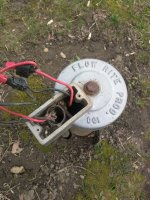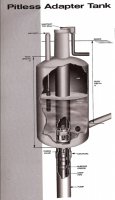marshallda
New Member
Hello all. I was wondering if anyone could give me any advice or knowledge that might help me with my water problems.
We bought an old house in Michigan, it's pretty small, the previous owners bought it for nothing and flipped it. As a result we have found lots of shortcuts that were taken.
On Christmas morning, we woke up to no water. Later that day we came home and we had water, it would start flowing ok and then the pressure would taper off after five seconds. It's been that way all winter making life pretty difficult. You can only do one thing at a time. No taps will work if the toilet's filling up (slowly I might add), showers are excrutiating, laundry takes forever and after you've used the water it does take time to recover.
Another observation, there isn't a pressure tank in the house. I can only think that due to a lack of space, the previous owners didn't think one was warranted, that can't help matters. I am guessing the well pump is doing all of the work.
So today, it's 60 degrees and I go outside, I look down at the well cap and see Flow Rite Prod 100. (picture attached) There's a cover with one large bolt on it and then the wiring is covered with a cap held on with two screws.
I decided that I wanted to have a look at what is going on under there. So off comes the cap to expose the wiring and then the bolt, the bolt is odd in that it is actually a female, a threaded piece in the well screws into it when you tighten the bolt. After removing the bolt, I tried tapping on the well cap with a hammer and was able to twist the cap, but not remove it.
That's when I started to get scared, with one tap of the hammer I could hear water pouring in the well pretty loudly I might add, there was no water in the house. I did manage to get the bolt back in and as I tightened it, the water slowed, and then stopped, we then had water back in the house.
So my guess is that this bolt connects to a metal pipe with the pitless connector on it, when I took the bolt off the seal broke and the adapter dropped out of alignment the pump's water was pouring back into the well and the water going to the house back tracked back into the well.
So I have a couple of questions:
1) Does anybody have a schematic of what the well looks like with a cap of this nature? I am guessing if I wanted to change the pump the whole cap, pipe and pump come out as one?
2) With the pressure being like this, would simply installing a 26 gallon pressure tank make a difference?
3) The well cap looks old, is it worth replacing the pump, pitless connector and well cap to a newer design?
I really appreciate any help you all can provide, the knowledge on this forum is outstanding.
We bought an old house in Michigan, it's pretty small, the previous owners bought it for nothing and flipped it. As a result we have found lots of shortcuts that were taken.
On Christmas morning, we woke up to no water. Later that day we came home and we had water, it would start flowing ok and then the pressure would taper off after five seconds. It's been that way all winter making life pretty difficult. You can only do one thing at a time. No taps will work if the toilet's filling up (slowly I might add), showers are excrutiating, laundry takes forever and after you've used the water it does take time to recover.
Another observation, there isn't a pressure tank in the house. I can only think that due to a lack of space, the previous owners didn't think one was warranted, that can't help matters. I am guessing the well pump is doing all of the work.
So today, it's 60 degrees and I go outside, I look down at the well cap and see Flow Rite Prod 100. (picture attached) There's a cover with one large bolt on it and then the wiring is covered with a cap held on with two screws.
I decided that I wanted to have a look at what is going on under there. So off comes the cap to expose the wiring and then the bolt, the bolt is odd in that it is actually a female, a threaded piece in the well screws into it when you tighten the bolt. After removing the bolt, I tried tapping on the well cap with a hammer and was able to twist the cap, but not remove it.
That's when I started to get scared, with one tap of the hammer I could hear water pouring in the well pretty loudly I might add, there was no water in the house. I did manage to get the bolt back in and as I tightened it, the water slowed, and then stopped, we then had water back in the house.
So my guess is that this bolt connects to a metal pipe with the pitless connector on it, when I took the bolt off the seal broke and the adapter dropped out of alignment the pump's water was pouring back into the well and the water going to the house back tracked back into the well.
So I have a couple of questions:
1) Does anybody have a schematic of what the well looks like with a cap of this nature? I am guessing if I wanted to change the pump the whole cap, pipe and pump come out as one?
2) With the pressure being like this, would simply installing a 26 gallon pressure tank make a difference?
3) The well cap looks old, is it worth replacing the pump, pitless connector and well cap to a newer design?
I really appreciate any help you all can provide, the knowledge on this forum is outstanding.



